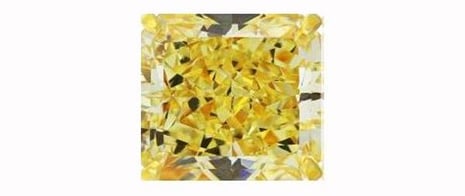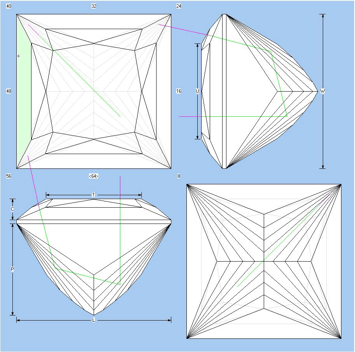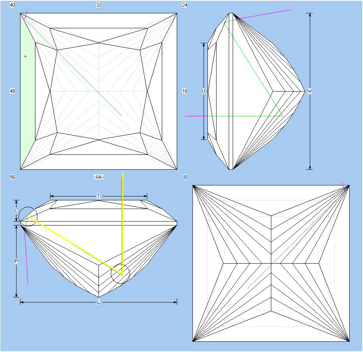Some years back my company received a ‘natural fancy yellow’ diamond which was a poorly cut cushion shape (to say the least). The request from our customer was that we re-cut this into a properly proportioned cushion. The copy of the grading report stated that it was a natural fancy yellow. I called our customer and informed him that the diamond does not have the body color of a fancy yellow. Before I agreed to start the work, the calls went back and forth, and with my last call I sounded the warning; 'this is an M color.' He replied; 'cut the diamond, I will fight them on the color; they have to honor their former report!'
So how did this credible laboratory arrive at the color? This is what happened: The diamond in question had four natural yellow radiation stains on the girdle. The cutter decided to use geometric color induction to enhance the color of the diamond. By lowering the pavilion angle he caused the girdle of the diamond to reflect in the pavilion, creating the illusion that the diamond was fancy yellow. Yes, the diamond looked marginally fancy yellow, but the body color suggested otherwise. It had the typical 'crushed ice' look of a fish-eye diamond like the one in the image below.

Well, we went ahead and re-cut the diamond into a beautiful and bright cushion with excellent light return. Our customer submitted the cushion to the same laboratory with the original report. The answer came back after a while and yes, they called it an M color. When he challenged the laboratory, they answered that the diamond had been substantially changed and it does not resemble the one they originally graded! The reputable laboratory failed to take the true body color of the diamond into consideration in the first instance, to call it what it really was - an M color. They were fooled by the ‘face up’ color of the diamond.
Come to think about it; no one in their right mind would buy a fish-eye round brilliant (girdle reflecting in the pavilion), but many jewelers have no problem buying fish-eye fancies. So the next time you are presented with a fancy color diamond, have a look at the TBC (true body color). If it does not exhibit similar saturation of color in the side as in the face up view, then rather pass.


The two images of a princess cut above demonstrate the principle of geometric color induction AKA the fish-eye effect. The image on the left is that of a normal princess with the pavilion mains on 40°. The image on the right has the pavilion mains on 33°, resulting in the pavilion facets reflecting the girdle and part of the crown girdle facets. Bear in mind that facets are mirrors and they will reflect everything they ‘see’ resulting in what is refered to as ‘virtual facets.’ It’s these virtual facets reflected in the pavilion of a fish-eye diamond which causes the ‘crushed ice’ look.
Geometric color induction always comes at the expense of light return. It has for a long time been the norm to cut fancy color diamonds into fancy shapes and the reason is obvious. Unlike round diamonds, fancy shapes can be manipulated as there is larger margin for proportion deviation and market tolerance in fancy shapes.


 RapNet Blog
RapNet Blog





